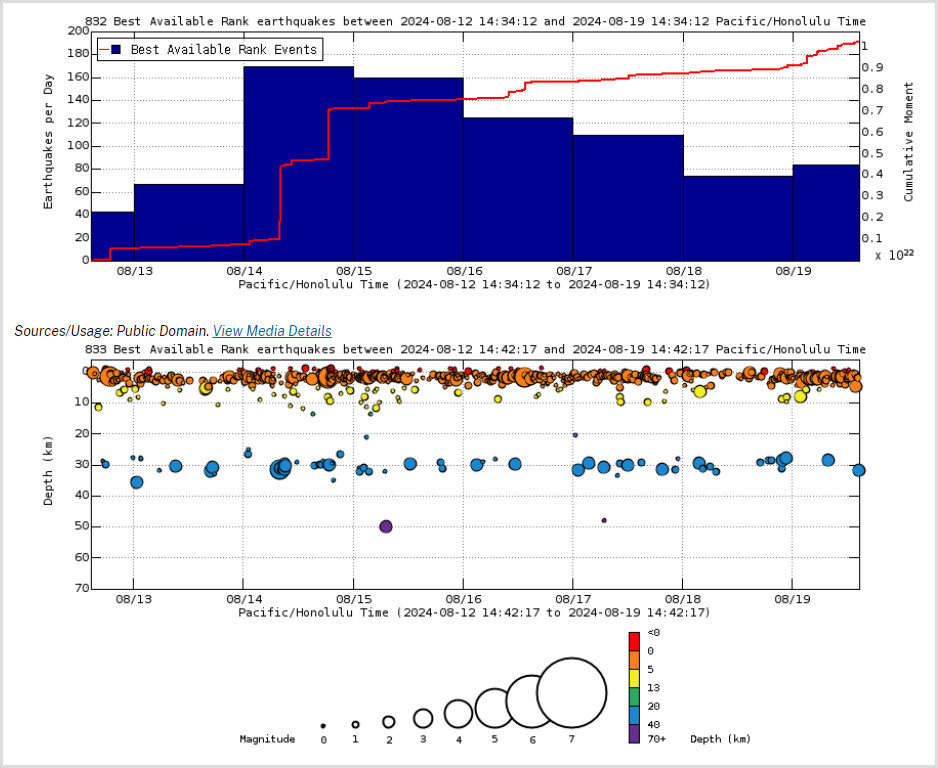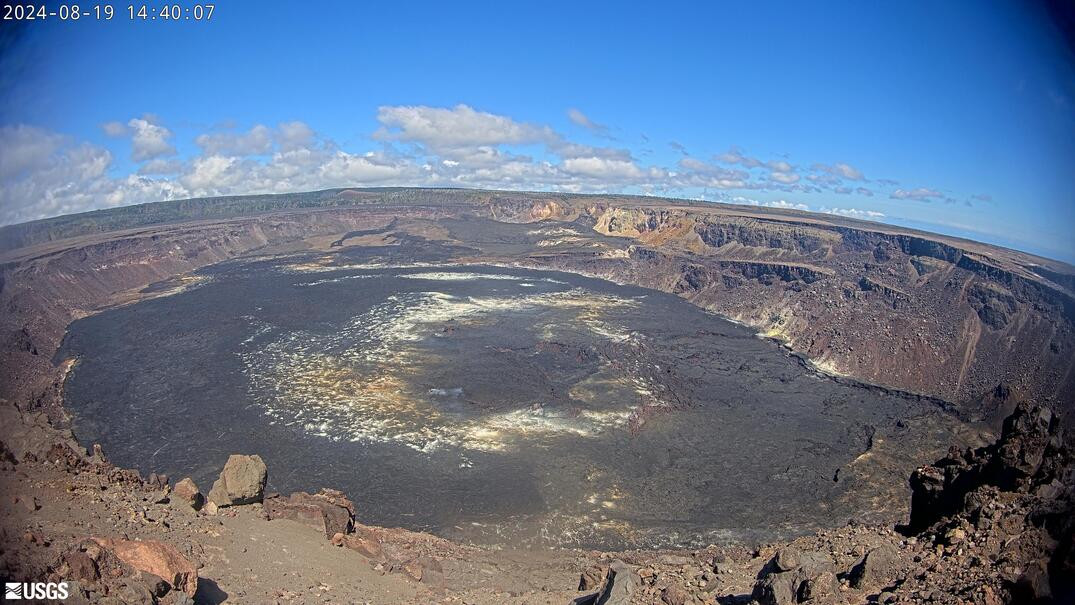(BIVN) – Kilauea is not erupting, and the USGS Volcano Alert Level remains at ADVISORY.
Scientists with the Hawaiian Volcano Observatory have noticed a decrease in activity in Kīlauea’s middle East Rift Zone, compared to last week. Meanwhile, there has been a slight increase in inflationary ground deformation at the summit.
Most of the earthquakes detected over the past day have been located beneath the upper East Rift Zone.
From the USGS Hawaiian Volcano Observatory on Monday, August 19:
Summit Observations: Approximately 12 earthquakes were detected beneath Kaluapele (Kīlauea’s summit caldera) over the past 24 hours. Most were located beneath and to the south of Halema‘uma‘u at depths of 1–3 km (0.6–1.9 mi) below the ground surface with magnitudes of less than M2.0. There has been a slight increase in the rate of deformation recorded by summit tiltmeters, particularly at Sandhill (SDH), which is sensitive to motions in the southern part of the caldera. The gradual inflationary trend is also seen on GPS instruments around the summit region. The most recent measurement of the summit’s SO2 emission rate was approximately 70 tonnes per day on August 13, 2024.
Rift Zone Observations: Approximately 54 earthquakes were detected beneath the upper East Rift Zone (UERZ) over the past 24 hours, most of which were located between Puhimau Crater and Koʻokoʻolau Crater and near Pauahi Crater. Most had magnitudes below M2.5 and depths ranged from 1–3 km (0.6–1.9 mi) below the ground surface. The ESC tiltmeter in the UERZ has recorded no significant changes over the past day.

Above Top: Number of earthquakes per day during the past week (blue bars). The red line is the cumulative moment (energy) release. Bottom: Depth of earthquakes during the past week in the area shown on the map above. Depth is reported relative to sea level, which is equal to a depth of zero on the above plot. On both figures, circle-size represents magnitude, and color indicates depth. (USGS graphs)
Activity in the middle East Rift Zone has slowed compared to last week. Approximately six earthquakes were detected in the middle East Rift Zone (MERZ) between Maunaulu and Puʻuʻōʻō within Hawaiʻi Volcanoes National Park. Most occurred near Kānenuiohamo and Makaopuhi Crater at depths of 1–3 km (0.6–1.9 mi) below the ground surface and magnitudes less than M2.0. Inflation recorded by the POC tiltmeter, located on the north flank of Puʻuʻōʻō, has slowed significantly and nearly leveled off in the past two days. HVO released an Information Statement on August 8 summarizing recent activity, interpretations, and possible scenarios associated with recent activity in the MERZ.
Measurements from continuous gas monitoring stations downwind of Puʻuʻōʻō in the middle East Rift Zone—the site of 1983–2018 eruptive activity—remain below detection limits for SO2, indicating that SO2 emissions from this area are negligible.
At this time, there is no evidence of seismicity or ground deformation beneath the lower East Rift Zone, and Southwest Rift Zone activity remains low.
Analysis: Pulses of earthquakes and ground deformation beneath Kīlauea’s UERZ from July 22–25, 2024, represented stages of an intrusion between Pauahi Crater and Maunaulu. The intrusive event is over, and magma has been repressurizing the storage system beneath Halemaʻumaʻu and the south caldera region. MERZ earthquakes and ground deformation observed since the intrusion indicate that magma is accumulating beneath the ground in the area of Makaopuhi Crater and Nāpau Crater, a well-known magma storage region in Kīlauea’s remote middle East Rift Zone. Additional earthquake swarms may occur with little or no warning and result in either intrusion of additional magma or eruption of lava in these regions.


by Big Island Video News3:04 pm
on at
STORY SUMMARY
HAWAIʻI VOLCANOES NATIONAL PARK - Activity in the middle East Rift Zone has slowed compared to last week, while a gradual inflationary trend has been observed near the summit.